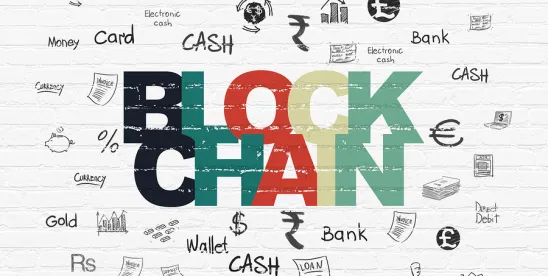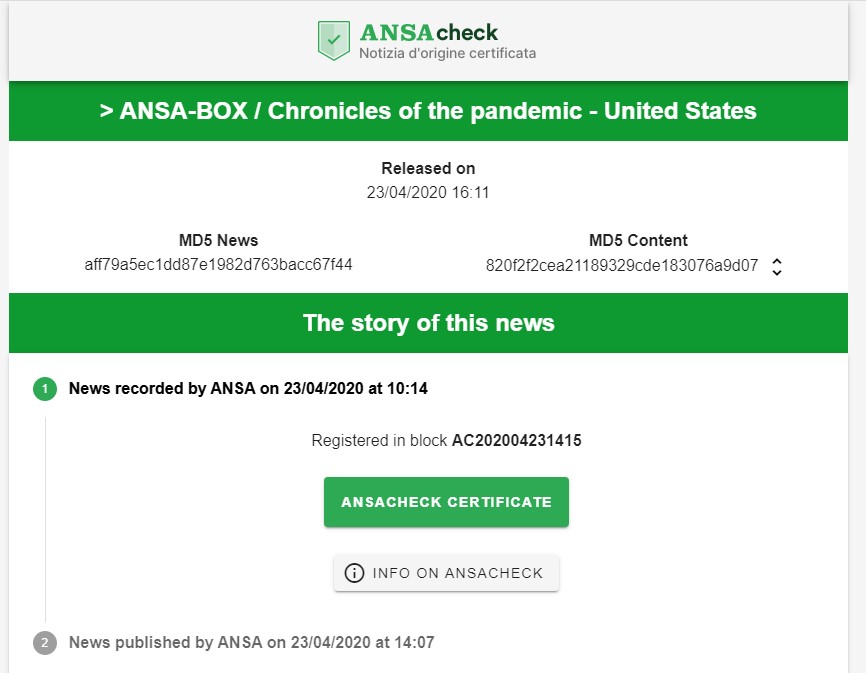The leading Italian news agency, Agenzia Nazionale Stampa Associata (ANSA), which represents 24 major Italian newspapers and distributes over 3,000 news articles daily, announced in early April that it has begun using a blockchain-based solution run on the Ethereum public blockchain to verify the origin of news stories that appear on ANSA platforms or are distributed to other sites, such as social media pages. Stories actually originating from the ANSA platform (without modification) now bear a green digital “ANSAcheck” certificate that informs readers that the preceding story is a verified ANSA news article and is not manipulated or spoofed content or a story that has been altered to spread disinformation. (An image of the ANSAcheck stamp is below; for an example of the certificate on the Internet, look for the digital stamp at the end of this ANSA story).
Under the ANSAcheck program, each news item from ANSA is reduced to a cryptographic hash using EY OpsChain Traceability technology and stored as a digital token on the public Ethereum blockchain. When a reader opens an ANSA story on a web browser, the browser compares the text of the article with the parameters recorded on the blockchain and displays the ANSAcheck digital seal if there is a match. If clicked on, the digital seal displays certain data, such as the date the story was published and other block information, as well as an ANSA Certificate, an example of which is shown below.
It is important to note that the digital seal only verifies that the story originated from ANSA, has not been modified and was published on a particular date. It does not affirm the veracity of, or “fact check,” the text of the original news story itself. The impetus for the rollout was to root out instances of false stories about the COVID-19 outbreak that deceptively bore the ANSA newswire byline in an attempt to trick readers into thinking they came from a legitimate source. Of course, misinformation spread by trolls and bots online and on social media is a continuing concern, so solutions like ANSAcheck will continue to be important going forward, including in the fight against deepfake videos. Thus, projects like the News Provenance Project, which would use a permissioned blockchain to provide readers with a way to verify the source of news photos, are not surprising.
During the COVID-19 health crisis it is especially important for readers to be able to get information from trusted sources, and the ANSAcheck solution is one way to identify verified news sources.
The combination of smart contracts and blockchain technology has created new opportunities to conduct business, including innovative ways to enhance traceability, not only in the context of news and media but also in other areas in which verifiability and transparency are important. For example, blockchain is currently being tested to trace the provenance of goods like sustainably-sourced coffee and to create efficiencies by sharing supply chain event data with parties involved in international container line shipping. For deeper insight into the legal issues in this areas, please see our Practice Notes, Blockchain and Supply Chain Management and Best Practices: Smart Contracts. While tracing goods in the supply chain from their source through the international shipping and customs process is more multifaceted than verifying the source and text of a news article displayed on the Internet, similar principles are at work. In both situations, a blockchain solution allows parties to track and trace items (in this case, news articles) and obtain a secure, validated record of their provenance. In the current pandemic, blockchain is being looked at for applications in virus response, such as the potential for helping connect medical providers with needed equipment during the COVID-19 outbreak and perhaps the ability to produce reliable COVID-19 immunization passports stored on the blockchain. Given that blockchain has been dubbed the “trust machine,” it is not surprising that ANSA is using the technology to verify the origin of online news and give readers confidence that they are viewing news from a reputable source.
Authored by Jonathan Mollod




 />i
/>i




